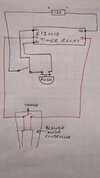I know this forum is full of electricians, but I'm hoping one of you guys is also an expert in electronics and can help me with a project.. if so, keep reading!
I am trying to run a 56V Ego leaf blower on a timer, using a remote momentary switch.
The timer relay I am using is a Tele E1ZM10
The control circuit is 12VDC.
Terminals 15 and 18 are used to replace the trigger microswitch on the blower.
Everything works fine - when the momentary push button is pressed, the 12V circuit completes momentarily and the relay contacts close for a set number of seconds. So the blower turns on for this number of seconds. Great. Except every now and then, (maybe once in 50 or so pushes) the blower stays on. The relay LED indicator shows that it has stopped counting and the relay contacts have opened, except the blower is still on. I've since realised that with the blower connected, there is 24V between 15 and 18, which is coming from the blower itself. So I'm assuming (as a novice) that the motor controller in the blower is sometimes holding the relay closed. So I wanted to fit a diode to stop this. I've no idea on the current but I was guessing a 60V 5A diode would do the trick. But where would it go? Logically I was thinking it would go between 18 and the return wire to the other side of the microswitch. But I have seen that people put diodes across the coil instead to stop back feed. If anyone is still reading and knows what I'm on about, then stand by and I'll try and post a picture.
A short term fix is to just press the push button again, and the relay returns to normal operation, but I need this to be reliable. I could always use an electromagnetic solenoid to physically push the blower microswitch on, but I'm worried about how much current this would draw as I'm on limited 12V battery power. Any thoughts gratefully received.
I am trying to run a 56V Ego leaf blower on a timer, using a remote momentary switch.
The timer relay I am using is a Tele E1ZM10
The control circuit is 12VDC.
Terminals 15 and 18 are used to replace the trigger microswitch on the blower.
Everything works fine - when the momentary push button is pressed, the 12V circuit completes momentarily and the relay contacts close for a set number of seconds. So the blower turns on for this number of seconds. Great. Except every now and then, (maybe once in 50 or so pushes) the blower stays on. The relay LED indicator shows that it has stopped counting and the relay contacts have opened, except the blower is still on. I've since realised that with the blower connected, there is 24V between 15 and 18, which is coming from the blower itself. So I'm assuming (as a novice) that the motor controller in the blower is sometimes holding the relay closed. So I wanted to fit a diode to stop this. I've no idea on the current but I was guessing a 60V 5A diode would do the trick. But where would it go? Logically I was thinking it would go between 18 and the return wire to the other side of the microswitch. But I have seen that people put diodes across the coil instead to stop back feed. If anyone is still reading and knows what I'm on about, then stand by and I'll try and post a picture.
A short term fix is to just press the push button again, and the relay returns to normal operation, but I need this to be reliable. I could always use an electromagnetic solenoid to physically push the blower microswitch on, but I'm worried about how much current this would draw as I'm on limited 12V battery power. Any thoughts gratefully received.
Attachments
Last edited:


